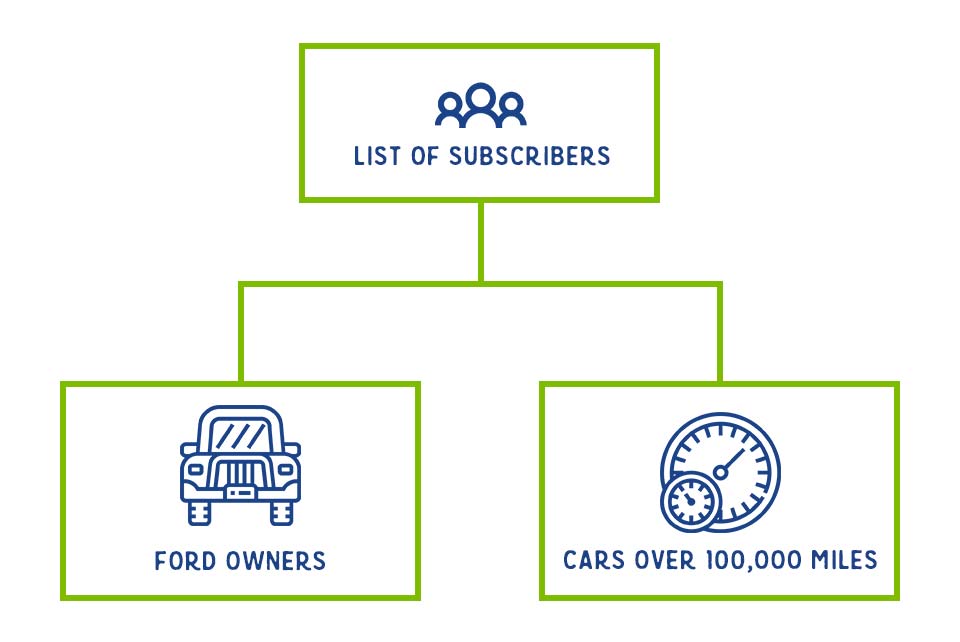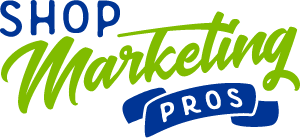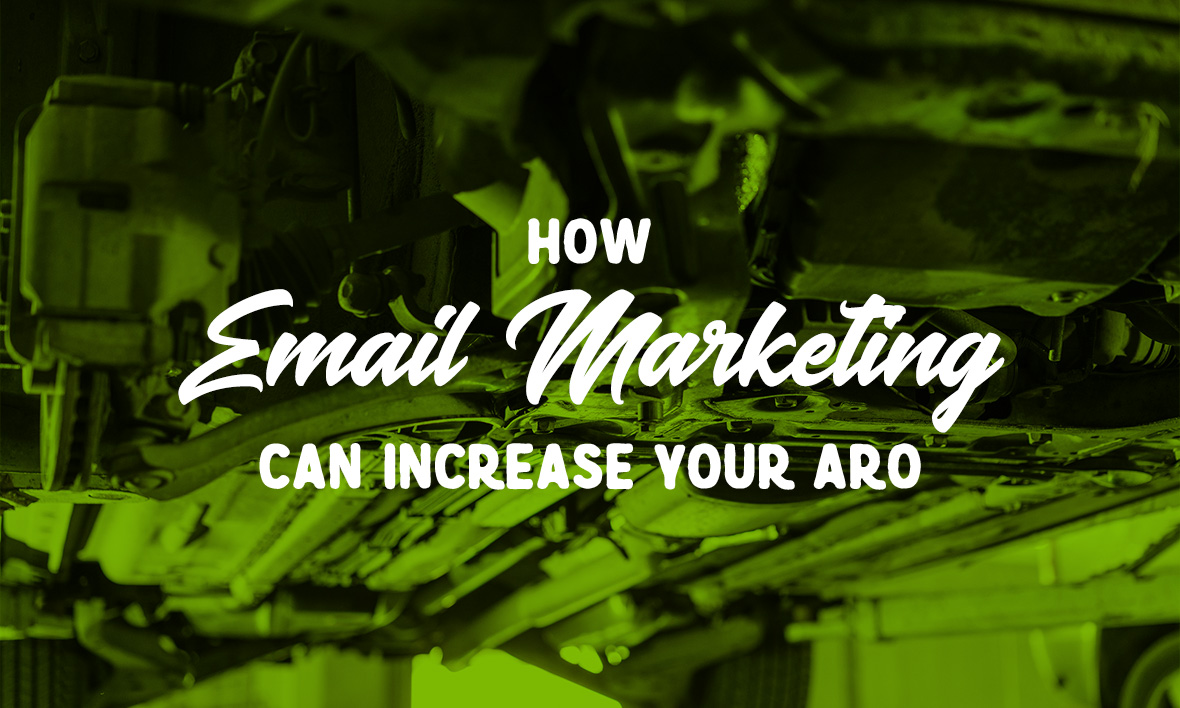Increasing your shop’s average repair order (ARO) is one of the most effective ways to maximize profits and run a more sustainable business.
It’s far more effective than focusing on a higher car count. Higher car counts come with the downsides of more stress on your staff, more paperwork to manage, and more chaos to your shop.
A higher ARO allows your shop to become more profitable — without adding to your overhead.
Most shop owners understand this — they struggle to find ways to increase their ARO. That’s where email marketing comes in.
Email marketing is one of your shop’s most powerful marketing channels — it offers you direct access to your customers’ inboxes. Compare that to other channels:
- Social media — Algorithms prevent organic posts from popping up in most news feeds — meaning if you want visibility, you have to pay for ads. Plus a majority of social media users barely register the content they scroll through.
- Blogging — There’s no guarantee your target audience will read your articles. And it often takes months for Google to rank your content, making it pointless for experiencing faster growth.
- Ads — Not only is this channel costly — many people have become savvy at ignoring ads.
- Direct mail — Similar to ads above, this method can be costly, and many people toss out “junk mail” before they ever even read the messaging.
Email marketing is different — but only if you know how best to approach it. Email marketing is not about sending weekly newsletters just for the sake of staying top of mind. At its core, email marketing is about:
- Understanding your audience
- Respecting the sanctity of their time
- Giving them something of value — every time you reach out to them
In this guide, we discuss specific ways you can use email marketing to increase ARO. But before we dive into these examples (such as how and when to cross-sell services), it’s crucial you understand how to personalize your email marketing efforts, so you see the biggest results — faster.
Oh, and yes, it’s true that in our “Ultimate Guide to Auto Repair Shop Marketing” we say “it doesn’t really matter what you send in your emails”. Don’t judge us until you read it, because we do contradict that statement in this article. For many shops — we believe it’s true that there’s value in just being seen in the inbox — but for the shops who are looking to maximize their marketing, you’ll want to provide value in every email.
Email Personalization — How to Target Customers with Laser-Like Accuracy
One of the most critical email marketing concepts to understand is that personalization is everything.
And to be clear, personalization goes well beyond ensuring emails include each recipient’s name. By personalization, we mean having the ability to segment your email list into sub-groups, based on specific parameters.
The diagram below is a simple visualization of what we mean:

In this diagram, the top box signifies your entire (unsegmented) list. Many businesses we work with send email blasts to this list only — and wonder why their email marketing ROI falls short of expectations.
The answer is simple: a lack of personalized messaging. Think of the different types of people who make up your email list. They may include:
- New customers
- Long-time customers
- Customers with older cars in need of constant repairs
- Customers who just got a different/new car
- Owners of specific makes and models
Targeting your general (unsegmented) list prevents you from personalizing your messaging based on these unique attributes.
Here’s what we mean:
In the diagram above, the two boxes below the general list represent two potential areas your shop can segment your list:
- Car types (in this case, Fords)
- Car mileage (in this case, 100k+)
Imagine if you could send an email to all Ford owners whose cars have exceeded 100k miles with a message such as:
Hey Brian!
Your Ford can run like a top well beyond 100,000 miles. But to do so, it needs a little extra love. Here are a few things we recommend you look at…
This message is personalized. As a result, it’s far more effective.
Here’s the good news: It’s relatively easy to set this up for yourself. Your shop management software contains all of that information — information that can easily be exported into your email platform.
You then use placeholders in your email for specific personalization identifiers, and your platform will take care of the rest.
In our example email above, you’d write something like this in your email software:
Hey {first.name}!
Your {car.model} can run like a top well beyond 100,000 miles. But to do so, it needs a little extra love. Here are a few things we recommend you look at…
Your email software will then replace {first.name} and {car.model} with the personalized information, based on the data gathered from your shop management software.
Yes, it really is that easy.
Below we detail suggestions on how to segment your general list to improve your personalization — so you can increase your ARO.
Specific Examples on How to Use Email Marketing to Increase ARO
1. Make clients aware of services you offer that they don’t know you offer
Many customers come to your shop for a specific reason, like an oil change or because their check engine light is on.
They aren’t necessarily aware that your shop offers a wide range of services (including, perhaps, new tires and auto detailing). If they aren’t aware, they aren’t likely to think of you when they need other types of work performed on their car.
You need to make them aware. The question is when?
Inundating customers in your shop with all the other services you provide isn’t a good idea. Chances are customers are already overwhelmed (because most car repairs are unexpected) and are likely in a hurry to get on with their day.
So email them instead.
You can email your entire mailing list whenever you add a new service or product — this is a good addition if you plan to send a newsletter.
But it still pays to personalize the messaging. Example:
Hey {first.name},
Did you know that we sell tires specific to {car.model}? We have a wide variety to choose from — and can help you decide which tire is right for you. And the best part? You can get your new tires installed at the same time as a regular service — like an oil change. That means one less appointment to fit into your busy schedule. Our team will help you determine if — and when — you need new tires. Then we can install new tires right then and there. It really is that easy!
2. Introduce customers to new products and services
Chances are your repair shop adds new products or services from time to time. Customers don’t know about these additions unless you tell them.
As mentioned earlier, overwhelming them with this information while they’re paying for another service — in your shop — is not ideal.
But emailing them with this information is.
Again, personalization will help differentiate your email from just another sales email.
Let’s say you recently added a high-tech wheel alignment machine to your shop. An email introducing this could look like this:
Subject: Are your {car.model}’s tires aligned? Find out for free
Hey {first.name}, last time your {car.model} was in the shop, we didn’t have the machinery to measure your wheel alignment accurately. We do now. And here’s the best part — we’ll check your alignment absolutely free the next time you schedule service with us (for something like an oil change).
Poor alignment can wear away tires faster. And for a {car.model}, new tires can cost close to a thousand dollars. Meanwhile, our alignment service costs just $75 — and only if you actually need the alignment.
First thing’s first. Schedule your next service with us so it’s on the books. We’ll make sure to check your alignment — for free.
[Schedule service]
This entire email can be replicated for all your customers. But that slight personalization — adding the car model — can help your customers feel like you’re speaking directly to them.
It can make it more likely that they’ll schedule that service.
3. Introduce a loyalty program based on dollars spent at your shop
Your shop management system should capture how much your customers spend when they come to your shop. Capitalize on that information by rewarding customers who spend more at your shop. You do this with a loyalty program.
Here’s how:
- Identify a threshold you want to work. Let’s say you want to introduce this loyalty program to any customer who spent at least $250 in your shop in one visit.
- You then email these people, letting them know that they’ve automatically been added to your VIP loyalty program. That means after $500, they save $20 on oil changes (your ‘reward’ can be anything of value, really).
- Now, here’s the key: Use personalization to list out services you offer, specific to the model or age of their car. For example:
- Since your {car.model} has more than {mileage} miles, it’s a good time to get the following checked or replaced:
- Then make it easy for them to schedule an appointment to address some or all of those recommendations.
4. Introduce time-sensitive or seasonal deals
As we mentioned earlier, email is the most direct way to reach your customers — exactly when you want.
This lends itself beautifully for time-sensitive deals. For example, spring is a great time to send an email blast reminding folks to get their A/C’s checked.
Better yet, add a sense of urgency to this offer with a limited-time deal:
Book your A/C checkup before midnight tonight, and save $10.
This short window could increase conversions — no one wants to miss out on a deal they know won’t last for long.
By the way, we discuss different psychology tactics you can use in your email copy further down in this guide.
5. Cross-sell based on personal data
Customers are more likely to make a purchase if they know others — like them — have made that same purchase.
In the case of your customers, this comes in the form of promoting services or products that other customers — who own similar cars — often get, or making them aware of common problems you’ve noticed on the specific make and model they drive.
Example:
Hey {first.name}, we wanted to let you know that over the last few months, we’ve seen a few dozen folks who also own {car.model} cars come in for service. When servicing their car, we noticed {common.problem}. This could become a safety issue when overlooked. We recommend scheduling an appointment soon, before it becomes a problem. The good news is if your car has this same issue, we can take care of it right at our shop. The cost of the service is {cost} — a special price we’re offering to loyal customers like you.
Again, this approach employs a limited time/sense of urgency approach. This tactic is tricky — there has to be a viable service worth sending this message for. But if there is, it can be incredibly rewarding.
How to Use Psychology to Increase ARO
Personalizing emails to your subscribers, and utilizing the examples above, can increase your ARO. But it also helps to know how to craft your copy around specific psychological tactics — so that your subscribers are more inclined to convert.
Don’t worry — this isn’t complicated. We’ve simplified it by turning it into a checklist, below. You won’t use all of these tactics in your emails. But the checklist will make it easy to ask yourself: how did I increase the chances my customers will convert?
- Price anchoring: When giving customers a choice between more than one product or service, list the most expensive product/service first. That makes all subsequent products/services in the email seem like a bargain.
- Price type: Speaking about pricing, data shows people are far more influenced by dollar-off savings vs. percentage savings. So, they like to see $25 off a service, vs. 10% off. It’s easier for them to understand the benefit.
- Cross-sell: We provided an example of this earlier, where we suggested you cross-sell based on what like-minded customers have purchased.
- Focus on the loss: Talk about what your customers will lose if they don’t purchase, rather than what they would gain by buying. Example:
- Don’t waste $1,000 on new tires because of poor alignment. Schedule your wheel alignment with us today.
- Scarcity: As things become less available, they become more desirable. In your instance, it’s more likely you’ll use time as the less available resource (“This discount will only last until X”).
- To-do lists: These (like the inspection report we referenced earlier) motivate customers to buy. People like to see progress in the form of a complete to-do list. They get motivated to purchase more to complete the list. But just like in our example earlier, be sure to demonstrate which steps are done (cross them out). You want your customers to feel a sense of accomplishment.
- Rewards: These can come in the form of a VIP membership or punch card (spend X dollars, get Y % off). Rewards also work as a way to get people to subscribe to your mailing list (or stay on there once you’ve added them). For example, you can say that once a month you pick five subscribers to give a free oil change.
- Social proof: When you recommend a product or service in an email, add a testimonial from other customers — if you can. For example, if you’re trying to get more people to come in for an A/C tuneup before summer, add a quote from a past customer about how quick and easy the process was.
Importance of Building Rapport — Respect the Inbox
Many of the repair shops we work with don’t have an existing email marketing strategy in place. Once they establish one, they typically see incredible returns on their investment.
That being said, one of the most significant errors we see is the misuse of email marketing. One of the most straightforward pieces of advice we can offer is this:
Always put yourself in your customers’ shoes. For example, would you want to get an email from a business every day? Or even every week?
Probably not.
Do you like getting emails that don’t offer you any real value?
Doubtful.
It’s essential that you respect the sanctity of the inbox. People are wary about providing businesses their email addresses — once you get an address, treat it like gold. Here are a few ways to do that:
- Build rapport and trust with your customers. Don’t use marketing jargon. Use your unique voice. This makes it easier for customers to connect with your company.
- Be transparent. This follows suit with the bullet point above. It helps you connect with your customers. Examples of this include spotlighting your employees, showing photos and videos of ‘behind the scenes’ work, sharing accomplishments and failures.
- Send emails that contain value. For example, is that “Happy Holidays” email really necessary? Sure, it’s nice, but countless other companies do the same thing. If you feel the need to email during, say, the holidays, make sure to add a limited-time coupon to the email.
Do you need a newsletter?
Newsletters are among the most common types of emails companies send to their customers. Monthly, for example, your shop might email all of its customers with a templated newsletter that includes a coupon of the month, news about the shop, and more.
This is an easy way to stay connected with your customers — but maybe not the most effective.
The issue with newsletters is they force you to send out an email no matter what, just to stick to a predetermined schedule. You risk sending out emails that contain little value — or risk getting overwhelmed by this scheduled task.
Some shops may benefit from a newsletter.
But we suggest you start with less formal email blasts that look like regular emails from your team to your customers.
These emails can be sent to customers whenever you have something of value to share with them.
Split testing (aka A/B testing)
This section goes into some advanced email marketing — but it’s worth understanding the concept of split testing (also known as A/B testing). If you’re still confused after reading this, you can always schedule a chat with us.
Split-testing means sending two different types of emails to your subscribers so you can assess which email type is more effective.
Most email marketing platforms have this built in. When split-testing emails, one of the first things our clients do is test different subject lines. For example, they’ll send one email to their list. 50% of the group will get a subject line such as:
- $50 coupon for your next service.
The other half of the group will get the same email, but with this as a subject line:
- Hey {Name}: Here’s a $50 coupon for you
Your email platform will capture the reports from each version of the email, so that you can tell which email gets more opens, and, as a result, which subject line is more effective.
This is a good approach — but we’d recommend going even further. Don’t just test different subject lines. That’s what we call a microvariant. Think bigger (macro). Test things such as:
- A simple email vs. a highly designed email — Many companies love sending out designed emails. Many customers respond better to emails that look more like, well, emails. Which do your customers prefer? Split testing will tell you.
- Length — Compare two versions of an email message — one that requires lots of scrolling to get to the end, and one that is extremely short.
- Tone/Voice — Test out different writing styles. For example, be funny in one email, and straight to the point with another.
Split-testing is a science of its own, and something we can help you with.
Email Marketing — An Effective Way to Increase ARO
Repair shops have been looking for ways to increase their ARO since long before computers and digital marketing existed.
But now that things like email do exist, it’s crucial that your shop know how to leverage the tools your customers use to increase your average repair order.
When done correctly, email marketing is the easiest way to:
- Connect directly with your customers
- Build trust and rapport
- Inform customers about different products and services they may benefit from
- Make customers feel like you’re always looking out for them
Fortunately, email marketing doesn’t have to be overly complicated. In fact, the more simple, the better. Your goal is to minimize the amount of hours you have to invest while still increasing revenue. Use the guide above to develop a robust email marketing strategy laser-focused on increasing your shop’s ARO.

About The Author

